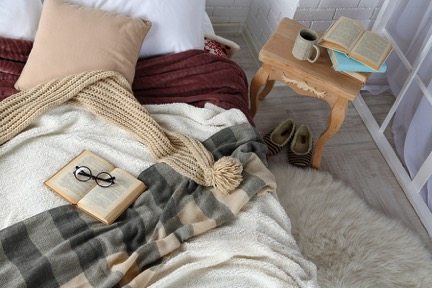We regularly clean our bathrooms, clothes, and dishes but dirt can still find its way into other areas of our home. Did you know mattresses and comforters can double in weight from dust, mold, bacteria, allergens, and dead skin that accumulate when we sleep on them? After reading this, you might be totally grossed out by what you’re not cleaning in your home. Don’t worry; we’ll also offer ways to clean them regularly.
Mattress
Unfortunately, you can’t just take your mattress to the laundromat or dry-cleaners and expect it to fit (you’ve seen the Febreze commercials). But that doesn’t mean you shouldn’t, or can’t, clean it regularly to remove germs and dust. Though it may not be appealing, it is possible to clean stains from the mattress with a little elbow grease.
First, vacuum your mattress. This removes a lot of dust and dirt that can keep you from getting sick and protects it from future stains should any liquid be spilled on the mattress.
Upholstery cleaner and a sponge or cloth work for spot cleaning. For most stains, you can try an enzyme cleaner or rubbing alcohol. Often times even a citrus spray or mild dish detergent will work. For odors, try disinfectant and odor sprays to start.
You can also use a mattress pad to serve as an additional layer of protection between you and the mattress. It will absorb moisture and other dirt and can be easily thrown in the washing machine with bedding. This doesn’t mean you won’t ever have to clean your mattress, but it will make it easier to clean.
Comforter or bedspread
Just as the case with mattresses, it’s easy to forget your comforter gets as dirty as your sheets. In some cases, you can throw a comforter or duvet in the washing machine, according to the directions on the tag. Treat stains and problem areas with a pre-wash before washing.
However, it may be worth taking your bedspread to the dry cleaners. Most washing machines aren’t large enough to accommodate a comforter and you don’t want it to overflow or vibrate loudly when the load becomes uneven. Drying at home is tricky, too, because you’d want to hang it on a clothesline and no one has the room for that.
If it’s made of wool or you have concerns about the color bleeding, do not attempt to clean at home. Dry clean it every time.
In between washings, you can vacuum or air out blankets on a clothesline to remove dust and keep them fresh.
Shower Curtain
Shower curtains can generally be taken care of with a little all-purpose cleaner, but don’t hesitate to throw it in the washing machine every once in a while. Just use the gentle cycle and wash in cold water. Hang it up to dry, but don’t return it to the shower until it’s fully dry or you’ll just get it moldy again.
Rugs
Of course rugs and carpets can be vacuumed regularly but stains do happen occasionally. Instead of rearranging the furniture to cover them up (we know that’s tempting), tackle the stain with some shaving cream. With an old shaving brush or clean paintbrush, work the shaving cream into the stained area. Then, use a damp rag to wipe away the cream and stain. Blot dry with a fresh cloth, preferably a white one, so the color doesn’t transfer into a new stain.
Dry cleaning is also a great idea for small or area rugs that are hard to clean or have a lasting odor. It’s so much easier, too.
Pillows
Fluffing a pillow isn’t just for looks; this removes most dirt and dust, keeping the pillow light and clean. Many times, pillows can be thrown into the wash for a gentle cycle. Foam or polyester pillows can be hand washed, but never put the foam pillows in the dryer. Hang these to dry, rotating regularly.
For decorative and throw pillows, spot clean with mild soap or read the directions for hand washing in cold water. No matter the type or use of pillow, be sure to check for stains, tears and holes before washing.
As you can see, there are ways to clean many of these things yourself, but why waste the time and cleaning products when you DriveCleaning.com will pick up and drop off your freshly cleaned pillows, rugs and comforters?



